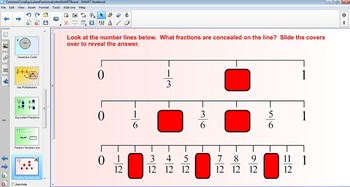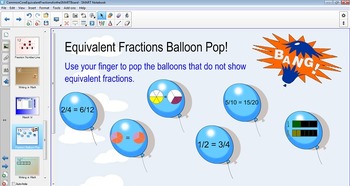Common Core Equivalent Fractions for the SMART Board
- NOTEBOOK (SMARTboard) File
Description
Equivalent Fractions for the SMART Board {Common Core Aligned}
In this CCSS-aligned SMART Board lesson on Equivalent Fractions, students will explore different ways to find equivalent fractions using interactive whiteboard manipulatives and number sense. This SMART lesson file also includes real-world problems and 'Writing in Math', a 'Match It!' game, and interactive Test Prep through hands-on digital interaction, a Balloon Pop interactive activity, Pizza Fractions, Math Journal prompts, and more!
☰ This product can be imported into Promethean ActivInspire (Click File--->Import--->and choose your SMART Notebook file to open)
HOME SCHOOL USERS: Use the SMART Interactive Viewer
(a FREE SMART Technologies application that will allow you to view and use this file).
Common Core State Standards Addressed:
Number & Operations—Fractions 1
Extend understanding of fraction equivalence and ordering.
1. Explain why a fraction a/b is equivalent to a fraction (n × a)/(n × b) by using visual fraction models, with attention to how the number and size of the parts differ even though the two fractions themselves are the same size. Use this principle to recognize and generate equivalent fractions.
Grade 4 expectations in this domain are limited to fractions with denominators 2, 3, 4, 5, 6, 8, 10, 12, 100.
© Copyright MrTechnology, 2014





